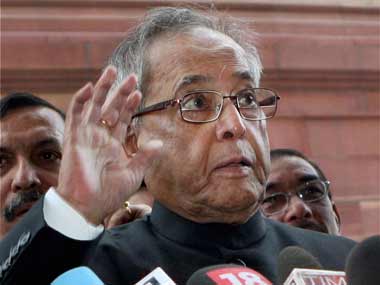In one of his anthemic songs that fed the counterculture movement, Bob Dylan observed wryly that “you don’t need the weatherman to know which way the wind blows.”
Much the same can be said of rating agency Standard & Poor’s most recent report that prepared the ground for a downgrade of India’s sovereign rating. You didn’t need the S&P weatherman to know which the economic wind was blowing.
For everyone except Finance Minister Pranab ‘Micawber’ Mukherjee , who is perennially living in the hope that “something will turn up” to miraculously fix the economy, it has been evident for a long while now that the Indian economy has been grinding down, that structural deficiencies are piling up, that policy paralysis afflicts the UPA government, and that the government is clueless about how to fix a decidedly broken economy.
[caption id=“attachment_340712” align=“alignleft” width=“380” caption=“The government is yet again passing the buck to the RBI. PTI”]
 [/caption]
[/caption]
Yet, the government’s response to the release of the report has been extraordinarily prickly. Mukherjee “rejected” the report - whatever that means - and Finance Ministry mandarins and Congress lackeys have begun to tilt at windmills by ridiculing the rating agency’s “ understanding of Indian politics ”.
More insidiously, a whisper campaign is on to paint S&P’s report as a “political hit-job”: this bizarre conspiracy theory holds that the primary S&P credit analyst who authored the report, Joydeep Mukherji, is a relative of a BJP leader from Paschim Banga. And that the candid comments in the report about the dysfunctional nature of the relationship between Prime Minister Manmohan Singh and Congress president Sonia Gandhi point to the political nature of the report.
The only thing missing is for Digvijaya Singh to miraculously connect the dots and establish an RSS conspiracy behind S&P’s report.
Rating agencies are, of course, far from infallible (as was made clear by their ratings fiasco that contributed to the 2008 financial crisis); and yes, the business of credit ratings is intensely political ( as we’ve observed here ). But for Pranab Mukherjee and his mandarins to go to town to “shoot the messenger” and make yet more out-of-whack projections about the robust nature of the economy shows up the government as being acutely in denial.
The fact of it is that the government’s failure to address structural deformities in the system for years together has played havoc with Pranab-da’s fiscal numbers. Worse, at precisely the wrong time in the macroeconomic cycle, the UPA government, under Sonia Gandhi’s stewardship, has gone on a spending binge on grandiose, ill-conceived and underfunded welfarist schemes. These in turn have bloated the deficits and stoked inflation.
Rather than address these through supply-side initiatives and bold reforms, the feckless UPA government has in recent years “outsourced” all macroeconomic policy to the RBI, which has responded to double-digit inflation in the only way it could: by hiking interest rates.
That has predictably ground down economic growth rates - yesterday’s IIP numbers were only the latest validation of that - but has not entirely vanquished inflation. Data due out tomorrow will likely confirm that inflation is running_higher_ than real GDP growth - as it has been for some time now.In other words, we’re in stagflation territory.
After yesterday’s IIP data, the predictable outcry for a cut in interest rates has gone out again. In one of the most bizarre responses ever, the stock market actually rose despite the anaemic data - because it believed that the prospects for a rate cut now stand enhanced.
The stock market is a “rate cut” junkie looking for a quick fix; but the inflation data due out tomorrow will likely rob them of the fix they crave for.
Sure, the RBI may yet deliver a rate cut - under political pressure and against its own wisdom. But that will only compound the fundamental structural problems in the economy, fixing which will take a lot longer.
As CLSA economist Rajeev Malik observes , the call for interest rate cuts appears to ignore the fact “government inaction” is more to blame (than high rates) for the “precipitous drop in economic growth”. And given the entrenched inflation levels, cutting rates now will worsen things.
“Boostingaggregate demand via interest rate cuts rather than enhancing aggregate supply will only worsen the inflationary pressures in the near term,” Malik notes. “Even if an investment upturn adds to aggregate supply, it does so with a lag. In any case, boosting aggregate demand from, say, higher investment should be matched by shrinking the fiscal overhang and moderating consumption growth. In the absence of such finely balanced recalibration - itself a challenge - India will suffer a more protracted macro adjustment.”
The pressure being brought to bear on the RBI to cut rates amounts to the most egregious instance of buck-passing by Mukherjee. And now, it appears that having landed the economy in a fine mess, he is preparing to give up his post in return for a sinecure in the Rashtrapati Bhavan.In the annals of political history, it’s about the biggest reward for policymaking failure as one can hope to expect.
Venky Vembu attained his first Fifteen Minutes of Fame in 1984, on the threshold of his career, when paparazzi pictures of him with Maneka Gandhi were splashed in the world media under the mischievous tag ‘International Affairs’. But that’s a story he’s saving up for his memoirs… Over 25 years, Venky worked in The Indian Express, Frontline newsmagazine, Outlook Money and DNA, before joining FirstPost ahead of its launch. Additionally, he has been published, at various times, in, among other publications, The Times of India, Hindustan Times, Outlook, and Outlook Traveller.
)